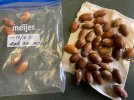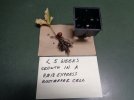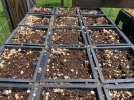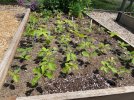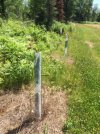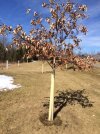A tap root is a trade-off that a tree makes. To ensure that it gets sufficient water to survive, it starts by putting a lot of energy into the tap root and there is little branching. Trees uptake nutrients and water based on the number of fine terminal roots, but if those fine terminal roots can't reach water, the tree dies. The top few inches of soil often dry out before a tree can be established, so it doesn't matter how many fine terminal roots a tree has if they can't reach the water. By putting energy into the terminal root, the tree sacrifices both top growth and root branching, but it survives.
When we use a root pruning system, we are changing the balance of that tradeoff. When the tap root is air pruned, it causes root branching, mostly in the first 4" above the prune. Since the tap root is terminated, the tree puts its energy into root branching (more fine terminal roots) and more top growth. More top growth means more photosynthesis which means more energy production and more terminal roots means more water and nutrients (provided they can be reached).
So, when we decided to use a root pruning container system, we commit to making sure the rootball can reach the needed water and nutrients. By the time the root system of a tree has filled a 1 gal RB2, it can be transplanted, IF it has sufficient water that it can reach. In some climates (I'm borderline) the soil will not dry out deep enough to kill the tree, but it may be limited. That is why many planted from a 1 gal will survive but few will thrive in my area. Keep in mind, I provide no supplemental water to trees in the field. By the time a tree's root ball has filled a 3 gal RB2, it has plenty of access to water in my climate. If I were in a more arid region, I would direct seed.
You can get much faster tree development using a root pruning container system, but you have to use it properly and understand the concepts. That thread I linked in the previous post shows an example. There is no free ride. That fast development comes at the cost of caring for the trees for a season or two depending on your location and making sure the tree does not need to "insurance policy" of a tap root.
By overwintering, I mean keeping the tree alive over the winter in a container so you can care for it for a second growing season. How you over winter containerized trees will depend on location. I'm far enough south that I simply sealed off a room in my basement and open a window. In some locations you can simply put them along side a warm building and pile straw on them. In some place you may need to dig holes in the ground and cover them with soil. Once again, it is understanding the concept and applying it to your situation. You want to tops to stay dormant all winter. Provided you have correct trees for your zone, they can be completely exposed. The roots, however need to be kept warm enough they at they don't freeze hard. Once dormant, the trees will use little water over the winter but they will use some. If you overwinter them outdoors, they usually get enough moisture. If you do it indoors, they do need watered occasionally.
Thanks,
Jack

